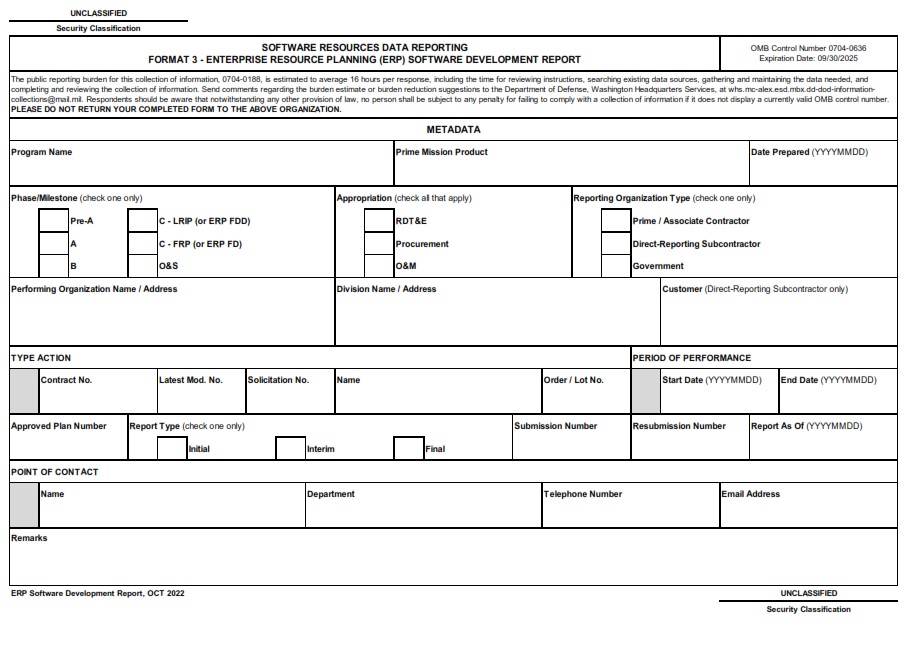Table of Contents
FREE-ONLINE-FORMS.COM – DD Form 3026-3 – Enterprise Resource Planning Software Resources Data Report – In today’s fast-paced business world, the effective management of resources is crucial for success. As companies strive to streamline their operations and maximize efficiency, the implementation of Enterprise Resource Planning (ERP) software has become increasingly prevalent. However, the challenge lies not only in selecting the right ERP system, but also in harnessing its full potential by utilizing relevant data resources effectively. This is where the DD Form 3026-3 comes into play – a comprehensive report that delves deep into the resources data generated by ERP software, providing invaluable insights for decision-makers and stakeholders.
Imagine being able to unlock the hidden secrets within your company’s resource management processes – from supply chain optimization to financial forecasting and beyond. The DD Form 3026-3 offers a window into this world of opportunities, allowing businesses to uncover patterns, trends, and correlations that could revolutionize their strategic planning and operational execution. In this article, we will explore how this vital document empowers organizations to extract actionable intelligence from their ERP software resources data, enabling them to stay ahead in an ever-evolving marketplace. Join us as we delve into the transformative potential of DD Form 3026-3 and discover how it can propel businesses towards sustainable growth and competitive advantage in the digital age.
Download DD Form 3026-3 – Enterprise Resource Planning Software Resources Data Report
| Form Number | DD Form 3026-3 |
| Form Title | Enterprise Resource Planning Software Resources Data Report |
| Edition Date | 10/18/2022 |
| File Size | 231 KB |
What is a DD Form 3026-3?
The DD Form 3026-3, otherwise known as the Enterprise Resource Planning Software Resources Data Report, is a vital tool used by the Department of Defense to collect and analyze data related to enterprise resource planning (ERP) systems. This form serves as a comprehensive repository for information on ERP software resources across different branches and agencies within the DoD. It captures crucial details such as system configuration, usage statistics, maintenance schedules, and any issues or challenges faced in implementing ERP solutions.
One of the key benefits of the DD Form 3026-3 is its ability to provide visibility and transparency into the diverse landscape of ERP software resources utilized across the Department of Defense. By centralizing this information, decision-makers can gain valuable insights into resource allocation, identify areas for improvement or standardization, and make informed decisions regarding future investments in enterprise resource planning technologies. Additionally, this form aids in promoting collaboration and knowledge sharing among various entities within the DoD that are leveraging ERP systems for mission-critical functions.
In conclusion, while the DD Form 3026-3 may seem like just another bureaucratic requirement at first glance, it plays a critical role in enhancing operational efficiency and effectiveness within the Department of Defense’s enterprise resource planning landscape. Its comprehensive nature empowers stakeholders with valuable data that can drive strategic decision-making and foster synergy across different units and agencies. This form exemplifies how meticulous data collection and analysis can lead to tangible improvements in managing complex software resources within large organizations like the military.
Where Can I Find a DD Form 3026-3?
If you’re wondering where to find a DD Form 3026-3, look no further than the Defense Logistics Agency (DLA) website. The DLA serves as the primary source for this Enterprise Resource Planning (ERP) software resources data report, providing access to a wide range of essential forms and documents for military personnel and organizations. By visiting the DLA website or contacting their customer service, individuals can easily obtain the necessary DD Form 3026-3 for their ERP needs.
Additionally, for those who are part of the Department of Defense (DoD) or affiliated organizations, access to the DD Form 3026-3 may also be available through internal databases and communication channels within their respective units. Utilizing these internal resources can streamline the process of obtaining this critical form and ensure compliance with ERP reporting requirements within DoD operations. Overall, understanding where to find a DD Form 3026-3 is essential for effectively managing ERP software resource data in military environments.
DD Form 3026-3 – Enterprise Resource Planning Software Resources Data Report
Enterprise Resource Planning (ERP) software plays a crucial role in modern business operations, enabling organizations to integrate and manage various business processes and functions. The DD Form 3026-3, also known as the Enterprise Resource Planning Software Resources Data Report, provides valuable insights into the utilization of ERP resources within an organization. This report offers detailed information on the allocation of resources, such as manpower, financial investment, and technology infrastructure, providing decision-makers with key data for strategic planning and resource optimization.
One of the standout features of the DD Form 3026-3 is its ability to capture real-time data on ERP usage across different departments and units within an enterprise. By analyzing this data, organizations can identify potential bottlenecks or inefficiencies in resource allocation and usage, leading to targeted improvements that can enhance overall operational effectiveness. Furthermore, this report serves as a benchmarking tool for evaluating the return on investment in ERP software by comparing resource utilization against predefined performance metrics.
In today’s fast-paced business environment, access to accurate and comprehensive data is essential for making informed decisions. The DD Form 3026-3 empowers businesses with valuable insights into their ERP resources, enabling them to optimize efficiency and drive better outcomes across various functional areas. By leveraging this robust reporting tool effectively, organizations can position themselves for sustained success in an increasingly competitive marketplace.
